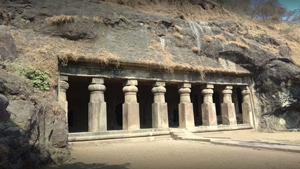ELEPHANTA CAVE IN MAHARASTRA
Elephanta Island, also known as Gharapuri is located in the Mumbai harbor,10 kilometers to the east of the city of Mumbai in the Indian state of Maharashtra. The island covers an area of about 16 kilometers at low tide. Thought to have been built between the 5th and 8th century C.E., a true example of Hindu cave culture, it consists of seven caves which can be divided into two groups. The first is a large group of 5 Hindu caves while the second is a smaller group of two Buddhist caves. Its presence on the world map is due to a unique group of caves, which was identified by UNESCO as a World Heritage site in as early as 1981. The Elephanta Caves can be reached by ferries that ply from the Gateway of India.
 The island was originally a Hindu place of worship and was called Gharapuri until the Portuguese rule began in 1534. They renamed it Elephanta after they found a large stone statue of an elephant near their landing-place. The sculpture, which was in a poor state of preservation, was later repaired and installed at the Bhau Daji Lad Museum at Jijamata Udyan in Mumbai. It was an active place of worship for the island’s Hindu residents well until the 1500s when the Portuguese took control of the island. The caves suffered much damage under the Portuguese, with its stone sculptures even being used for target practice by soldiers.
The island was originally a Hindu place of worship and was called Gharapuri until the Portuguese rule began in 1534. They renamed it Elephanta after they found a large stone statue of an elephant near their landing-place. The sculpture, which was in a poor state of preservation, was later repaired and installed at the Bhau Daji Lad Museum at Jijamata Udyan in Mumbai. It was an active place of worship for the island’s Hindu residents well until the 1500s when the Portuguese took control of the island. The caves suffered much damage under the Portuguese, with its stone sculptures even being used for target practice by soldiers.
The ground plan of the temple in the main cave indicates that the northern entrance was the principal one. The main temple consists of a large pillared hall and a freestanding shrine at the west end of the hall. The huge Mahesamurti statue is housed in the massive hall. At a height of 6.3m, this impressive sculpture depicts Shiva in his three-headed aspect: as Creator (right), Protector (center) and Destroyer (left). Though Maheshamurti is considered by most to be the principal object of worship, it is the linga shrine which stands facing the Nandi that is the main object of worship. The left panel depicts Yogishvaraj (Shiva as the Lord of Yoga) and the right shows Nataraja (Shiva as the Lord of Dance). Apart from these sculptures, we can also witness Ravananugraha, Uma-Mahesvara, Gangadhara, Kalyanasundara¸ Andhakasuravadha, Ardhanarisvara, Nrittamurti, etc. we can also see the shrine in the east wing, the chapel in the west wing. In the west wing, we can see Lord Shiva a yogi in the veranda accompanied by Lord Vishnu riding Garuda, Yama on his buffalo.
The cave is being protected by Archeological Survey of India (ASI) and responsible for the continuous maintenance, support, and preservation of the monument.

